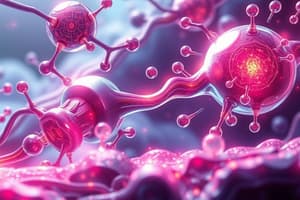Podcast
Questions and Answers
What is a key example of energy conversion in plant cells?
What is a key example of energy conversion in plant cells?
- Digestion
- Fermentation
- Photosynthesis (correct)
- Cellular respiration
How do biologists categorize species?
How do biologists categorize species?
- By their chemical composition (correct)
- By their reproductive methods
- By their geographical location
- By their color and size
What process culminates in metabolism within cells?
What process culminates in metabolism within cells?
- Biochemical reactions (correct)
- Protein synthesis
- DNA replication
- Cell division
What fundamental feature do all cells share in organisms?
What fundamental feature do all cells share in organisms?
What role does photosynthesis play in plants?
What role does photosynthesis play in plants?
What is the overall significance of classifying and categorizing lifeforms?
What is the overall significance of classifying and categorizing lifeforms?
What happens during metabolism in cells?
What happens during metabolism in cells?
Which of the following correctly describes a characteristic of living cells?
Which of the following correctly describes a characteristic of living cells?
Flashcards
Metabolism
Metabolism
The process that governs all living things. It involves chemical reactions within cells where energy is transformed and used.
Photosynthesis
Photosynthesis
The conversion of light energy into chemical energy, primarily occurring in plants.
Cell
Cell
The basic building block of all living things - a self-contained unit that carries out life's functions.
Biological Classification
Biological Classification
Signup and view all the flashcards
Species
Species
Signup and view all the flashcards
Microbiology
Microbiology
Signup and view all the flashcards
Biomolecule
Biomolecule
Signup and view all the flashcards
Evolution
Evolution
Signup and view all the flashcards
Study Notes
Cell Structure and Function
- All cells within similar species share fundamental similarities in structure and chemical composition.
- Biologists categorize life forms based on shared characteristics within species.
- Energy flow within cells is driven by biochemical reactions.
- Photosynthesis is a crucial cellular process converting light energy into chemical energy.
- Cellular metabolism is the complex sum of all biochemical reactions that occur within a cell.
Key Figures and Contributions
- Robert Hooke is recognized for his observations relating to the cellular structure of organisms.
- Matthias Jakob Schleiden's contributions relate to plant cells and their composition.
- Theodor Schwann's research focused on animal cell structures and their chemical makeup.
- Rudolf Virchow's work expanded the understanding of cell composition and function to their roles in disease.
- Antonie van Leeuwenhoek made significant contributions in the area of microbiology and the observation of single-celled organisms.
Studying That Suits You
Use AI to generate personalized quizzes and flashcards to suit your learning preferences.




